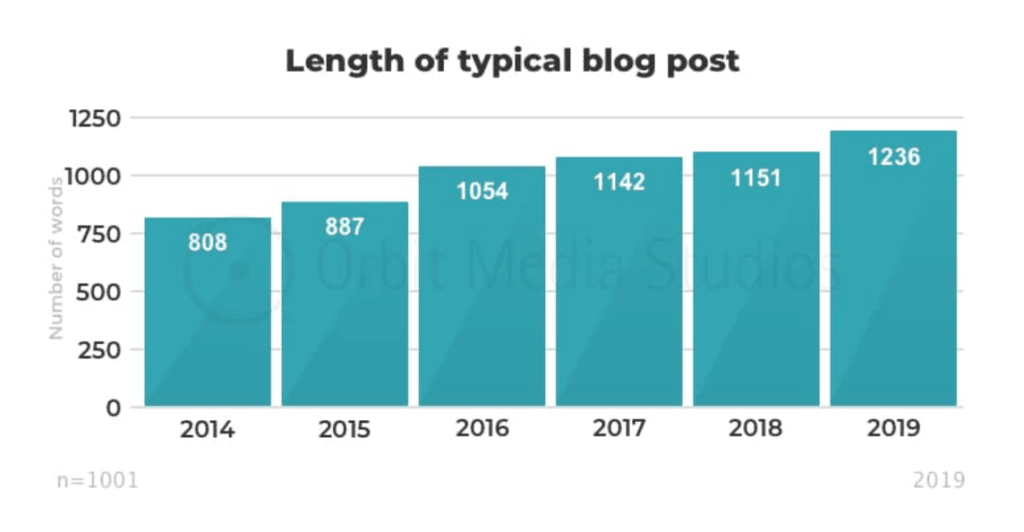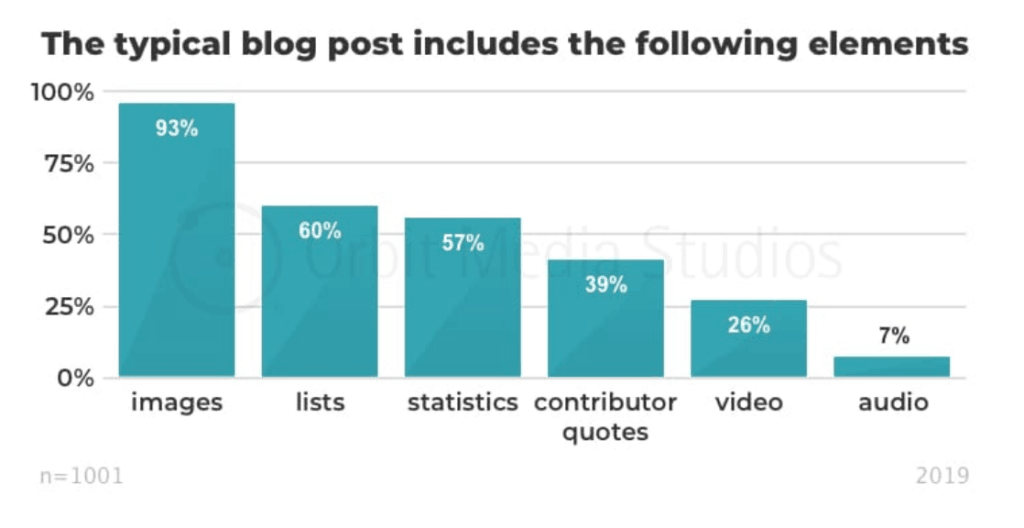Blogging Tips, Tactics and Trends: Survey Results
Blogging tips and tactics seem to be changing a lot. It used to be easy to get lots of people to share your blog posts. In a recent survey of 1000+ bloggers, the consensus was it’s getting harder to get readers to engage with content.
This is a huge deal.
If you are going to invest resources into creating and publishing blog posts, you want to know your target audience are finding, reading and engaging with those posts.
What can you do to improve the reach and engagement rates of your content?
Thankfully, our friends at Orbit Media Studios recently shared the newest results from their annual survey, which included over 1000+ bloggers and their take on creating blog content for business.
The results of this survey tell us what blogging tactics and strategies work best today. You can then use the insights gleaned from the survey to improve your own blogging.
This survey seems especially timely at the approach of a new year, when you may be starting to plan your content marketing strategy for 2020.
These results will show you what’s working successfully for top bloggers right now in terms of time, length, frequency, promotion and measurement.
While I am not suggesting that what works for the majority of bloggers will work for you, these insights can give you a great place to begin assessing and revising your blogging efforts. They’ll be especially useful if you are just starting out or are not seeing the results you’d like to see from blogging.
I encourage you to experiment with your approach to find what works best for your industry, business and target market.
No matter what you decide, however, remember that quality is more important that quantity.
Here are the results from 2019 Annual Survey of 1000+ Bloggers from Orbit Media Studios with my commentary.
Five Blogging Tips & Tactics to Improve Your Blog Posts
1. Blog post length and content
Blog post length has been trending in the direction of longer posts.
In fact, this year blog posts are 53% longer than they were six years ago. The length of a typical blog post went from an average of 808 words in 2014 to 1236 words in 2019.

The number of shorter posts (under 500 words) continues to decline, and the number of the lengthy 2000+ words is on the rise.
What is even more interesting is that the blog posts with over 1000 words produced stronger results than those with fewer than 1000 words. The strongest results were delivered by posts with over 2000 words.
To see what lengths of posts will net the best results for you, you need to experiment with their lengths. The majority of my posts are 1500-2500+ words, with some in the 3000+ range, depending on the topic.
Including multimedia in blog posts
The use of visuals in blog posts continues to rise. Audio inclusion, on the other hand, remains low.

Images make an excellent addition to a post as they catch a reader’s attention and help break up your text to make it easier to read. Using several images is ideal, especially if you are creating longer blog posts.
In fact, more than half of bloggers who use 4 to 10 images see strong results. More impressively, 75% of bloggers who use 10+ images see even better results.
The use of video has risen in the past few years: about 26% of bloggers now use it. Of all the types of media elements included in the survey, video produced the strongest results.
If video appeals to both your target market and your personal style, now is the time to consider incorporating a video strategy into your blog.
More than half of bloggers regularly use lists and statistics.
Lists can be exceptionally handy for readers, but with such an abundance of them, it would be wise to not overuse them, or else your post risks becoming just another list among many. Adding the occasional list can be an excellent inclusion to your blog, but ultimately variety is the key to success.
Including statistics within a blog post, when appropriate, is another powerful tactic to engage the reader. It can provide the proof for a point you are making. It is important to reference the source of your stats, or you will be at risk of losing the credibility you are trying to establish.
Additional reading: “How to Write Blog Posts That Get Read and Shared.”
2. Blog post frequency
How often should you publish your blog posts?
According to the survey, the publishing frequency ranges greatly: from more than once a day to irregular intervals over the course of a year, with the average falling around 2 to 4 times a month.

The frequency of your publishing comes down to the resources you’ve allocated to content marketing. Posting once a day requires a lot more resources than publishing once per week, especially if you are creating longer quality blog posts.
It is important to note, however, that the bloggers who blogged once a day found the best results.
That means the more often you can manage to post a quality blog post, the better results you are likely to see.
3. Writing and editing blog posts
The length of time it takes to write a blog post varies. It depends on your topic, how in-depth you want to explore it, your familiarity with the topic and your researching and writing skills.
The survey tells us the average article takes 3 hours and 57 minutes to write. This is up 65% since 2014.

But longer, more detailed posts will typically take longer to write. In fact, 19% of bloggers now spend 6+ hours on an average post.
Keep in mind that stronger results were reported by bloggers who invested 6+ hours per post as opposed to those who invested less than 6 hours.
As a general guide, when it comes to blogging, less is not more. A deeper dive into the subject, more words and more time are needed to create a high-quality blog post.
Editing your blog post
The survey also revealed that 30% of bloggers now use a formal editing process.

In fact, over half of bloggers now have, at a minimum, a second set of eyes to review their blog posts. This is critical. It is hard even for skilled writers to edit their own work. A second set of eyes helps ensure you catch most errors and improve the quality of the writing.
Bloggers who have a formal editing process report better results than those who do not.
Think about it this way: if you are going to invest resources to create content, it needs to look professional. You do this by hiring one or more experienced editors.
Remember, the quality of your posts (or lack thereof) will influence the way your readers perceive you: as either more or less trustworthy and authoritative.
4. Blog promotion
While it is important to create great content, there isn’t much point doing that if no one reads it. That is why promoting your blog is so important.
How do most businesses promote their blog content?
Over 97% of bloggers promote their blog posts on social media.

Bloggers also use two other key promotion strategies: SEO and email marketing. Both have seen a consistent increase since 2014.
Influencer outreach, on the other hand, has been decreasing since 2017.
The use of paid services by bloggers has also seen a significant decrease since last year.
Despite the decrease in the number of bloggers using these two blog promotion tactics, bloggers using influencer outreach and paid services saw the strongest results.
Bloggers using social media to promote their blog posts report it as the least effective method of blog marketing.

Additional Reading: “How to Optimize Blog Posts for SEO.”
5. Blog analytics
The final topic covered in the survey was measurement. Bloggers were asked how often they check their analytics.
Over 50% check their analytics on a regular basis.

But 16% rarely or never check their blog analytics. This is a staggering number.
If you don’t know how your posts are doing, how will you know what worked and what didn’t?
If you don’t know what works, you will waste your time and resources creating content your target market doesn’t want or need. Doing this will put you among the large number of bloggers having a hard time getting readers to engage with their content.
But if you keep track of what is of most interest to your community, you can create more content that readers engage with and that produces results.
Want proof?
Those who checked their analytics the most often saw the strongest results in the performance of their blogs.

The moral of the story is you will be more successful with your content in the future if you know how past content has performed. What isn’t measured can’t be improved!
Additional Reading: “The Ultimate B2B Content Marketing Checklist.”
Blogging tips to create your 2020 content marketing plan
There is no one-size-fits-all approach when it comes to blogging. What works for one business might not work for another. But we do know that some blogging practices produce better results than others for the majority of businesses.
Learn from these statistics so you can create a content marketing plan to improve your blogging strategy. Ultimately, you need to test some of these blogging tips and tactics to determine what works for your business and your target market.
But remember this: the Internet is flooded with content. The only way to differentiate yourself from the rest is to ensure your content is superior to the other content available. To do this, it may even make sense for you to publish your blog posts less often, focusing instead on producing higher quality posts.
Did any of these blogging tips, tactics and trends surprise you? Share in the comments below.
The post Blogging Tips, Tactics and Trends: Survey Results appeared first on Top Dog Social Media.
Contributer : Top Dog Social Media https://ift.tt/2OtIgMI
 Reviewed by mimisabreena
on
Thursday, November 21, 2019
Rating: 5
Reviewed by mimisabreena
on
Thursday, November 21, 2019
Rating: 5

















No comments:
Post a Comment